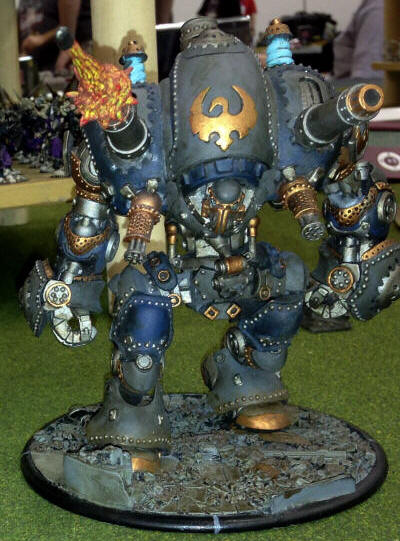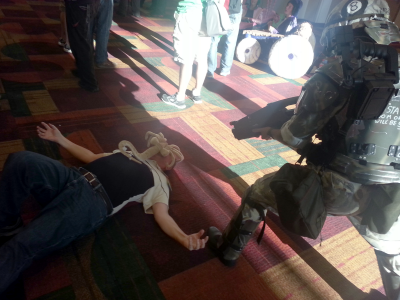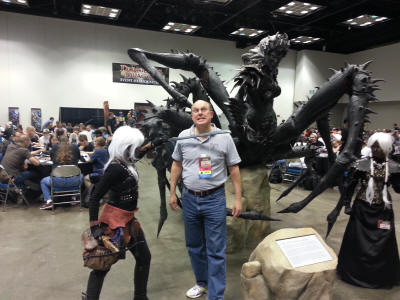GENCON Game Report
Oh, and land of a whole lotta games.
I met Eric Haines and his son Thursday noonish (having flown in that morning) and started playing games wtihin the hour.
|
|
|
| Playing MAMMOTH Settlers of Catan, United States | Playing "Village" in the city-blocked size main gaming area |
So, games first... what did we play and what did I enjoy? And, if you're not a gamer, skip over this section.
- Survive: Escape from Atlantis – This was a fast game with one marginal flaw (you have to place 10 figures with hidden values on the bottom and remember which are the high value ones, because you are not allowed to look during the game) and one significant flaw (you have “save this piece from the monsters” cards that removes what little strategy the game has). It’s a light game, with very little strategy, trivial tactical decision making (while you have options there are usual only one or two that make sense), and only the alternating gameplay (where you move your pieces, then move the monsters to try to destroy the other player’s pieces) keeps it balanced, since anyone getting too far ahead becomes the target for the other players. Still, entertaining, and good for younger players if you have them. Recommendation: Buy if you are looking for something to play after a pitcher of margaritas or you have very young players.
- Keyflower – This game had the most innovative mechanics of any game I played during GenCon. Three basic resource types, meeples, tools (square cardboard tokens) and … errrr…. Resources (wood pieces that represent gold, stone, iron, etc). Meeples are used to activate hexes, or bid on free hexes in the center (which, if you win, become assimilated in your colony but are still usable by other players). Meeple color is significant, and you are usually paying a lot of attention to your color mix. Activated hexes can give you resources, allow you to move resources, upgrade another hex, or a few other random specials. There’s the constant tension of using your meeples to activate something you want, and running the risk of not having enough to win bidding on the tile you want. The ability to move meeples from losing bids to other, less desirable hexes (or to activate things) keeps people from being completely destroyed during a turn. The tools (cardboard tokens) are slightly random and really don’t add much to the game… they are sometimes needed for resource production, they usually score some points, but generally they serve to make it a little harder to figure out what hexes you can use at any point in time. The good thing is that the mechanics can be picked up fairly quickly. The bad thing is the complexity of your options. Hex placement matters. Resource distribution and mix matters. Meeple number and color mix matter. What hexes you activate matter. Road and river alignment matters. There are things that play well together, meaning there’s a certain strategic depth to the game, which means the mix of hex types matter. And the mix of tools matters and so on. You’re always moving forward, but the sheer number of options and the difficulty in evaluating the value of the options makes this a “five plays to have a clue” kind of game. Recommendation: Buy, bring to Jeff Goldsmith’s for memorial day, then get some of the Caltech crew to play while you skip; watch them lock up like a windows PC and spend the entire weekend without moving.
- Spyruim – Another winner on innovative mechanics, with less complexity that Keyflower. It has a backstory that everyone completely ignored. It’s a card laying game with a few resource types (meeples, crystals, cash). The innovative aspect is in acquiring cards; you form a three by three grid, then players take turns placing meeples along the inside edges between cards. That allows you to bid on (or in some cases, activate) either card you are between. At any point, you can shift from “bidding” to “action” mode, and there’s a lot of tension around that, because shifting to action mode first gives you first choice in card selection. However, the cost of the card goes up based on the number of meeples around it, and you can, as an action, pull a meeple and make money (also based on number of meeples), so there’s a lot of “is he really after that, or is he going for cash, or is he just trying to make my card more expensive while he goes for the second card” kind of thing. Some of the acquired cards play well together, but the more you acquire, the more expensive it is place them, so there’s a strategic element and some aspect of picking and choosing wisely and avoiding things that don’t help that much. There are some special skills that seem worthwhile, and again play well with other cards. We got half way through a demo game at the vendor booth, and I liked the game enough to buy it, and then we played a full game in the lobby of the Omni, and I liked it a little less; it seemed like in the end game there were a lot of unpredictable and significant swings in VP totals, making good earlier gameplay meaningless. On the other hand, the last nine cards are always the same, and it might be that reviewing them before the start of the game, so you know what you need to grab the heavy hitters and are gravitating toward that, might mitigate that. Recommendation: Buy; still the best game we played at GenCon.
- Love Letter – This is a fun, 10 to 15 minute game consisting of a small (16, I think) number of cards. You’re trying to get a card that wins, while figuring out what the other players have (which, if you do, allows you to knock them out of the game most of the time). You can only hold one card at a time. Game play slowly reveals more information about the other players hands and it’s a toss up as to whether you can figure it out in time to win or you hit end game conditions.
- Village – A resource and action selection prioritization game (you go round the table multiple times, each person picking an action, getting a randomly distributed but visible resource for each action; what you pick is usually a combination of what actions you need and what resource type you need). End game scoring is a little obtuse but not horribly so. The game seems pretty balanced with multiple paths to victory. There’s one interesting mechanic, where you can trade off resources for “life” (there’s a counter that circles around and, when it hits midnight, “kills” one of your meeples, but one of the actions available is to get a new meeple). Since you get VP for dead guys, it’s still not at all clear that conserving your meeples makes any sense. Problem is, like with Keyflower, the options are legion and the value is hard to determine, making it a long game with fairly standard mechanics that you play until someone randomly wins. Recommendation: Skip it.
- Catan: Settlers Of America – We played the “Mammoth” version, with a board you walked on to place settlements and railroads. Yes, I said railroads. Despite looking like a United States Catan Map, this game has very little relation to Settlers of Catan. It’s a fairly standard resource collection and building game, with a little twist (you win by “delivering” things to other people’s settlements, and first in locks it, so there’s some “have to get there first” aspect to the game), except the map is big enough (in the game sense, not the size of the map we were playing on) that resource management is a bit of a pain. Recommendation: Skip it.
- Hanabi – This was a fun coop game; you have to arrange a set of cards by color and number in correct sequence. The trick is that you hold your deck so the other players can see it; on your turn, you can play one of your cards (that you can’t see), or you can give the other players hints about what cards they are holding (tell them all cards of one numeric value or one color). It was fast and fun, and easy to forget which card the other players told you about so you ended up discard something you needed or playing something that can’t be placed (which ends the game faster, leaving you less time to complete your stacks). Recommendation: Buy.
- Takenoko, the gay Panda Game – Work hard to make a pleasant habitat for the giant Panda by screwing the other players. Except not really; there’s very little player interaction (other than the standard “oh, I wanted to do that” kind of playing-in-the-same-sandbox thing). I liked the game when we were playing it and would have thought about buying it if it didn’t have Pandas, but the more I think about it, the more I think I don’t really think it’s a good game. Recommendation: It has Pandas. Blecccchhhh.
- Smash Up – Card game where you mix two random creature types (like Zombie Dinosaurs or Mechanized Wizards) and try to beat the other players to death. More entertaining conceptually than in actual play. Recommendation: Skip it.
- Trains – A tweener game, with some depth to it. It’s a dominion style deck building game, but instead of getting abstract land cards that choke your deck but give you VP, you place abstract “train tracks” on a board to win (and I mean abstract; your train track is a little square wooden token in a hex to say “I have track here”) and gain a "waste" carc that chokes your deck. However, the board has some complexity to it as well, and you have to evaluate the likelihood of the card you need verses your conflicting priorities on the board. Seems like a good, solid, play it five to ten times before you get board of it kind of game. Recommendation: Buy.
- Rex: Twilight Imperium – The game that would not end. A three and a half hour grind that has a rich universe and backstory that’s demonstrated by lots of interestingly named spaces that work exactly the same as every other space. Some random resource distribution occurs each turn to make two of the spaces different from the other spaces for a short time because now they have resources you don’t need on them. But you go for it anyway, because your other option is to land on a random space just for the hell of it. That’s only for two players; the other four actually do need resources, so they probably care (not really). Every race is different in ways that are hard to comprehend and harder to remember. You can have three way alliances so that the guy who gets to win by guessing the winner has a two in three chance of taking the game no matter what the outcome is, and you get to share your incomprehensible powers with your allies to further muddle the situation. Complex, lengthy combat with obscure winning conditions. Cards that have a one in twenty chance of randomly and completely screwing the winner in combat. And a orbiting dreadnought fleet that runs around destroying everything in a random number of squares, because the game isn’t murky enough without another factor thrown in for no damn reason. However, it made for a lot of goods jokes at the games expense while we played. Recommendation: Pass, pass, pass.
- Fresco – This was another tweener game… and actually close to Spyrium in being center of mass (which for me is moderate complexity, interesting mechanics, intermediate level of player interaction, and plays in 45-90 minutes). It’s an action selection game, and not untypically you trade off moving first for other things, in this case “mood” which can give or take away one from your five actions, and cost at market. Its marked as a family game for 10 or older, but it seems pretty complex for a ten year old to me. Recommendation: Buy, with a caveat… the guy giving us the demo suggested that the same company had another game, Edo, with similar mechanics but more advanced strategy, so that might be a better choice (they didn’t have a version to demo, unfortunately).

 |
|

 |
 |
 |
 |
 |
 |
 |
 |
 |
 |
 |
 |

| The Restaurants around the convention center had special menus, or or had the waitresses and waiters dress up in cosplay style outfits... including PF Changs. |
|
| Wouldn't be GenCon without the Batmoble. And yes, those are parachutes on the back end. I think it's the original, restored. |
 And I thought DC / Marvel superhero mash-ups were getting out of hand... how did these guys end up in the same room? |
 "Cardhalla" was a charity where anyone could build elaborate structures out of donated Magic The Gathering cards; they auctioned off "first shot" at knocking down structures with a coin, followed by a general free for all. Ultimately it netted close to $3000! The other charity was first strike at the 1800-plus balloon Chuthlu monster, which was then turned over to |
  kids for final dismemberment. Training the younger generation. |
 I was attacked by a face hugger from the "Aliens" movie. Fortunately the nice marine is going to remove it with his pulse rifle. Errrrr.... wait a minute.... |
 And captured by Evil Drow (a black skinned race of elves that live underground, for those that haven't followed D&D for the past twenty years). |


